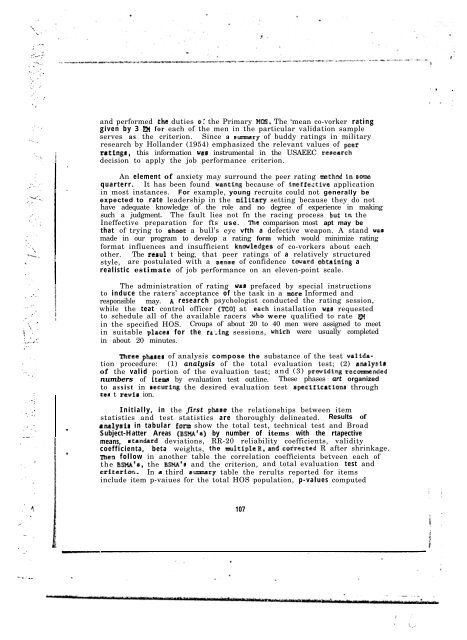Technical Report - International Military Testing Association
Technical Report - International Military Testing Association
Technical Report - International Military Testing Association
You also want an ePaper? Increase the reach of your titles
YUMPU automatically turns print PDFs into web optimized ePapers that Google loves.
.<br />
.<br />
and performed .the duties 01 the Primary NOS. The ‘mean co-vorker rating<br />
given by 3 En for each of the men in the particular validation sample<br />
serves as the criterion. Since a sumnary of buddy ratings in military<br />
research by Hollander (1954) emphasized the relevant values of peer<br />
ratings, this information vae instrumental in the USAEEC research<br />
decision to apply the job performance criterion.<br />
An element of anxiety may surround the peer rating mthod in aom<br />
quarterr. It has been found wantfng because of ineffestfve application<br />
in most instances. For example, young recruits could not generally be<br />
expected to rate leadership in the military setting because they do not<br />
have adequate knowledge of the role and no degree of experience in making<br />
such a judgment. The fault lies not fn the racing process but tn the<br />
Ineffective preparation for fts use. The comparison most apt may be<br />
that of trying to ahoot a bull’s eye vfth a defective weapon. A stand wss<br />
made in our program to develop a rating form which would minimize rating<br />
format influences and insufficient knowledges of co-vorkers about each<br />
other. The rem1 t being, that peer ratings of a relatively structured<br />
style, are postulated with a sense of confidence toward obtatnfng a<br />
realistic estimate of job performance on an eleven-point scale.<br />
The administration of rating wa8 prefaced by special instructions<br />
to induce the raters’ acceptance of the task in a mre Informed and<br />
responsible may. A research psychologist conducted the rating session,<br />
while the teat control officer (‘X0) at esch installation we requested<br />
to schedule all of the available racers who were qualified to rate @I<br />
in the specified HOS. Croups of about 20 to 40 men were assigned to meet<br />
in suitable place8 for the rb;ing sessions, which were usually completed<br />
in about 20 minutes.<br />
Three phases of analysis compose the substance of the test valfdation<br />
procedure: (1) analysis of the total evaluation test; (2) analysis<br />
of the valid portion of the evaluation test; and (3) providtng rccomnencled<br />
numbers of item by evaluation test outline. These phases art organized<br />
to assist in recuring the desired evaluation test speclflcations through<br />
te8 t rev16 ion.<br />
Initially, in the first phase the relationships between item<br />
statistics and test statistics are thoroughly delineated. Results of<br />
aoalyeia in tabular form show the total test, technical test and Broad<br />
Subject-Hatter Areas (B!SMA’a) by number of items with the rtapective<br />
means, standard deviations, RR-20 reliability coefficients, validity<br />
coefficienta, beta weights, the multipltR,and coirected R after shrinkage.<br />
men follow in another table the correlation coefficients betveen each of<br />
the BStU’a, the BSHA’s and the criterion, and total evaluation test and<br />
criteriorr. In u third suxnary table the rerults reported for items<br />
include item p-vaiues for the total HOS population, p-values computed<br />
107<br />
:. .









